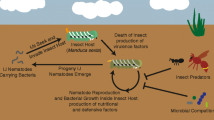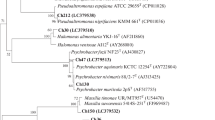Abstract
Nine strains of the terrestrial bacterial genusXenorhabdus, all isolated as symbionts of nematodes, were examined for their abilities to produce substances with antibiotic activites when grown in pure culture. All nine produced measurable antibiotic activities against one or more of the test strains utilized. The inhibition patterns indicated that different compounds were being produced by the various bacteria. Two of the species that showed particularly strong inhibition patterns were studied in detail. The inhibitory compounds were purified and identified. Strain R produced a mixture of active substances, the major components of which were hydroxyl- and acetoxyl-bearing indole derivatives, presumably produced via tryptophan. Strain Hb, on the other hand, produced only two antibiotics, 4-ethyl- and 4-isopropyl-3,5-dihydroxy-trans-stilbenes, which are presumed to arise via polyketide pathways.
Similar content being viewed by others
References
Devon, T.K., andScott, A.I. 1972. Handbook of Naturally Occurring Compounds, Vol. 1, Academic Press, New York.
Geissman, T.A., andCrout, D.H.G. 1969. Organic Chemistry of Secondary Plant Metabolism. Freeman, Cooper & Co., San Francisco.
Hastings, J.W., andNealson, K.H. 1977. Bacterial bioluminescence.Ann. Rev. Microbiol. 31:549–595.
Khan, A., andBrooks, W.M. 1977. A chromogenic bioluminescent bacterium associated with the entomophilic nematodeChromonema heliothidias.J. Invert. Palhol. 29:253–261.
Nealson, K.H., andHastings, J.W. 1979. Bacterial bioluminescence: Its control and ecological significance.Microbial Rev. 43:496–518.
Pasto, D.J., andJohnson, C.R. 1969. Organic Structure Determination. Prentice-Hall, Inc., Englewood Cliffs, New Jersey.
Poinar, G.O., Jr., Thomas, G., Haygood, M., andNealson, K.H. 1980a. Isolation of defective bacteriophages fromXenorhabdus spp. (Enterobacteriaceae).IRCS Med. Sci.: Microbiol. Parasitol. Infect. Dis. 8:141.
Poinar, G.O., Jr., Thomas, G., Haygood, M., andNealson, K.H. 1980b. Growth and luminescence of the symbiotic bacteria associated with the terrestrial nematode,Heterorhabditis bacteriophora.Soil Biol. Biochem. 12:5–10.
Poinar, G.O., Jr., Thomas, G., andHess, R. 1977. Characteristics of the specific bacterium associated withHeterorhabditis bacteriophora.Nematologica 23:97–102.
Reichelt, J.L., andBaumann, P. 1973. Toxonomy of the marine luminous bacteria.Arch. Mikrobiol. 94:283–330.
Scott, A.I. 1964. Interpretation of the Ultraviolet Spectra of Natural Products. Pergamon Press, New York.
Thomas, G.M., andPoinar, G.O., Jr. 1979.Xenorhabdus gen. nov., a genus of entomopathogenic, nematophilic bacteria of the family Enterobacteriaceae.Int. J. Syst. Bacteriol. 29:352–360.
Wehrli, F.W., andWirthin, T. 1978. Interpretation of Carbon-13 NMR Spectra. Heyden and Son, Ltd., London.
Author information
Authors and Affiliations
Rights and permissions
About this article
Cite this article
Paul, V.J., Frautschy, S., Fenical, W. et al. Antibiotics in microbial ecology. J Chem Ecol 7, 589–597 (1981). https://doi.org/10.1007/BF00987707
Received:
Revised:
Issue Date:
DOI: https://doi.org/10.1007/BF00987707
Key Words
- Bioluminescent bacteria
- symbiosis
- Xenorhabdus spp.
- anti-bacterials
- 3-(2′-acetoxy-3′-keto-4′-methylpentyl)-indole
- 3-(2′-hydroxy-3′-keto-4′-methylpentyl)-indole
- 3-(2′-acetoxy-3′-keto-4′-methylhexyl)-indole
- 3-(2′-hydroxy-3′-keto-4′-methylhexyl)-indole
- 3,5-dihydroxy-4-ethyl-trans-stilbene
- 3,5-dihydroxy-4-isopropyl-trans-stilbene




